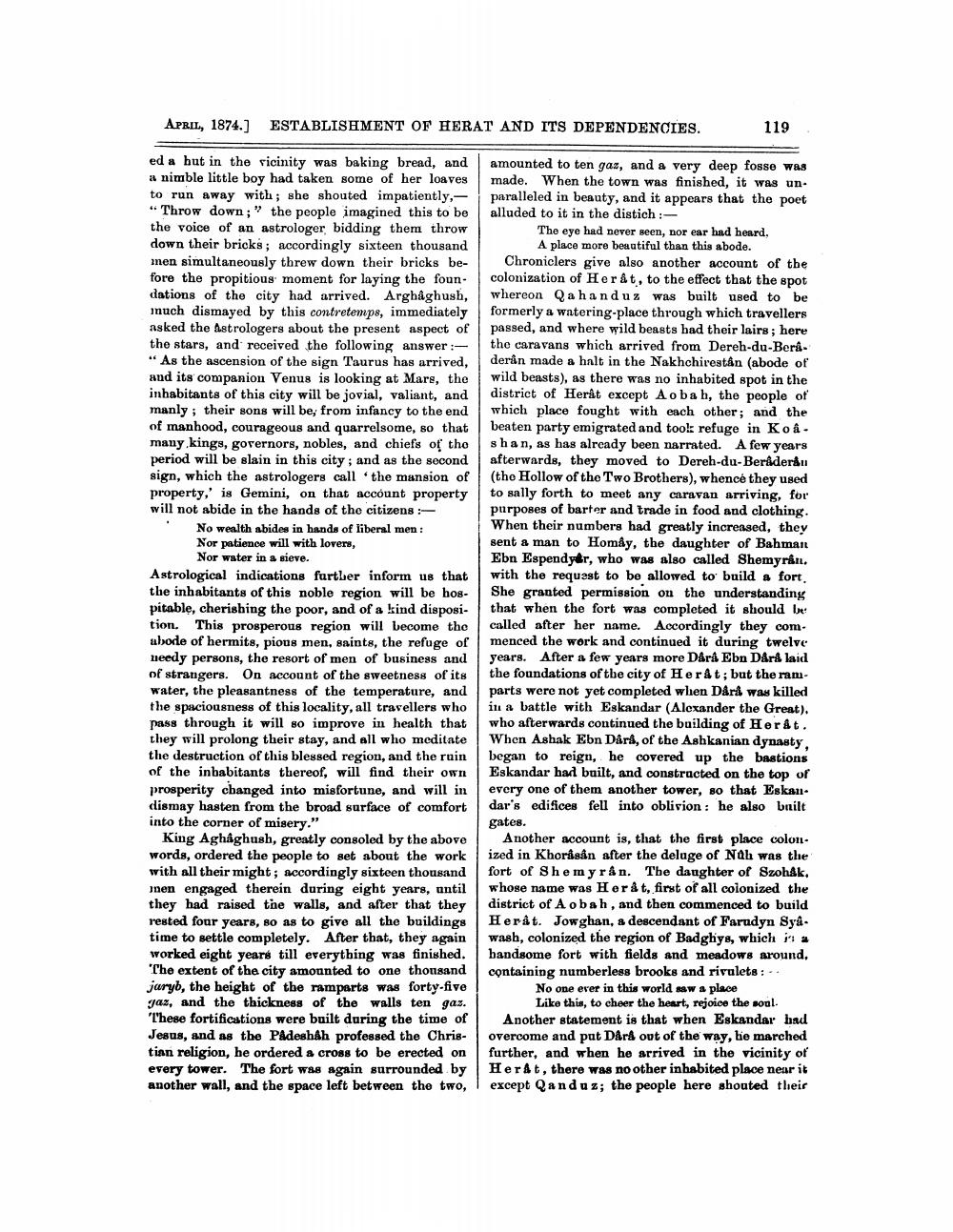________________
APRIL, 1874.) ESTABLISHMENT OF HERAT AND ITS DEPENDENCIES.
119
ed a but in the vicinity was baking bread, and a nimble little boy had taken some of her loaves to run away with ; she shouted impatiently, "Throw down;" the people imagined this to be the voice of an astrologer bidding them throw down their bricks; accordingly sixteen thousand men simultaneously threw down their bricks before the propitious moment for laying the foun. dations of the city had arrived. Arghåghush, inuch dismayed by this contretemps, immediately asked the Astrologers about the present aspect of the stars, and received the following answer :"As the ascension of the sign Taurus has arrived, and its companion Venus is looking at Mars, the inhabitants of this city will be jovial, valiant, and manly; their sons will be, from infancy to the end
manhood, courageous and quarrelsome, so that many kings, governors, nobles, and chiefs of tho period will be slain in this city; and as the second sign, which the astrologers call the mansion of property,' is Gemini, on that account property will not abide in the hands of the citizens
No wealth abides in hands of liberal men: Nor patience will with lovers,
Nor water in a sieve. Astrological indications further inform us that the inhabitants of this noble region will be hospitable, cherishing the poor, and of a kind disposition. This prosperous region will become the abode of hermits, pions men, saints, the refuge of zieedy persons, the resort of men of business and of strangers. On account of the sweetness of its water, the pleasantness of the temperature, and the spaciousness of this locality, all travellers who pass through it will so improve in health that they will prolong their stay, and all who meditate the destruction of this blessed region, and the ruin of the inbabitants thereof, will find their own prosperity changed into misfortune, and will in dismay hasten from the broad surface of comfort into the corner of misery."
King Aghåghush, greatly consoled by the above words, ordered the people to set about the work with all their might; accordingly sixteen thousand jnen engaged therein during eight years, until they had raised the walls, and after that they rested four years, so as to give all the buildings time to settle completely. After that, they again worked eight years till everything was finished. "The extent of the city amounted to one thousand jaryb, the height of the ramparts was forty-five gaz, and the thickness of the walls ten gas. 'l'hese fortifications were built during the time of Jesus, and as the PÅdeshåh professed the Christian religion, he ordered a cross to be erected on every tower. The fort was again surrounded by another wall, and the space left between the two,
amounted to ten gaz, and a very deep fosse was made. When the town was finished, it was un. paralleled in beauty, and it appears that the poet alluded to it in the distich :
The eye had never seen, nor ear had heard,
A place more beautiful than this abode. Chroniclers give also another account of the colonization of Heråt, to the effect that the spot whereon Qahanduz was built used to be formerly a watering-place through which travellers passed, and where wild beasts had their lairs; here the caravans which arrived from Dereh-du-Berederin made a halt in the Nakhchirestån (abode of wild beasts), as there was no inhabited spot in the district of Heråt except A obah, the people of which place fought with each other; and the beaten party emigrated and tool refuge in Koa. shan, as has already been narrated. A few years afterwards, they moved to Dereh-du-Beraderau (tho Hollow of the Two Brothers), whence they used to sally forth to meet any caravan arriving, for purposes of barter and trade in food and clothing. When their numbers had greatly increased, they sent a man to Homây, the daughter of Bahman Ebn Espendy&r, who was also called Shemyrån. with the request to be allowed to build a fort, She granted permission on the understanding that when the fort was completed it should be called after her name. Accordingly they com. menced the work and continued it during twelve years. After a few years more Dårå Ebn Dårå laid the foundations of the city of Herát; but the ramparts were not yet completed wlien Dari was killed in a battle with Eskandar (Alexander the Great), who afterwards continued the building of Heråt. When Ashak Ebn Dårå, of the Ashkanian dynasty. began to reign, he covered up the bastions Eskandar had built, and constructed on the top of every one of them another tower, so that Eskan. dar's edifices fell into oblivion : he also built gates.
Another account is, that the first place colon. ized in Khoråsån after the deluge of Noh was the fort of Shemyrån. The daughter of SzohAk, whose name was Heråt, first of all coionized the district of A obah, and then commenced to build Heråt. Jowghan, a descendant of Faradyn Syawash, colonized the region of Badghys, which is handsome fort with fields and meadows around, containing numberless brooks and rivulets : ..
No one ever in this world saw a place
Like this, to cheer the heart, rejoice the soul. Another statement is that when Eskandar had overcome and put Dårå out of the way, he marched
further, and when he arrived in the vicinity of | Herst, there was no other inhabited place near it
except Qanduz; the people here shouted their




